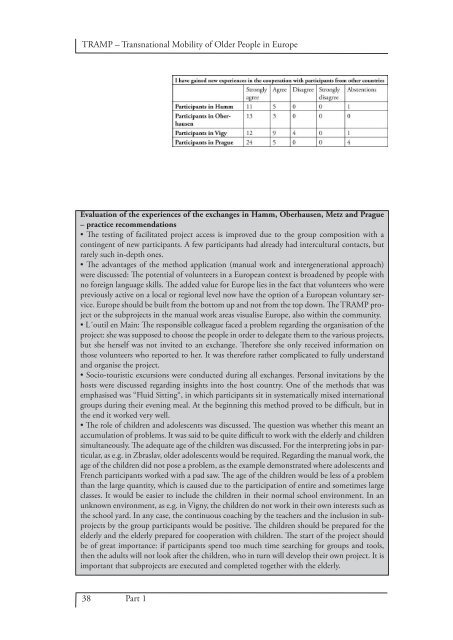Download - TRAMP - Arbeit und Leben DGB/VHS
Download - TRAMP - Arbeit und Leben DGB/VHS
Download - TRAMP - Arbeit und Leben DGB/VHS
Create successful ePaper yourself
Turn your PDF publications into a flip-book with our unique Google optimized e-Paper software.
<strong>TRAMP</strong> – Transnational Mobility of Older People in Europe<br />
Evaluation of the experiences of the exchanges in Hamm, Oberhausen, Metz and Prague<br />
– practice recommendations<br />
• The testing of facilitated project access is improved due to the group composition with a<br />
contingent of new participants. A few participants had already had intercultural contacts, but<br />
rarely such in-depth ones.<br />
• The advantages of the method application (manual work and intergenerational approach)<br />
were discussed: The potential of volunteers in a European context is broadened by people with<br />
no foreign language skills. The added value for Europe lies in the fact that volunteers who were<br />
previously active on a local or regional level now have the option of a European voluntary service.<br />
Europe should be built from the bottom up and not from the top down. The <strong>TRAMP</strong> project<br />
or the subprojects in the manual work areas visualise Europe, also within the community.<br />
• L´outil en Main: The responsible colleague faced a problem regarding the organisation of the<br />
project: she was supposed to choose the people in order to delegate them to the various projects,<br />
but she herself was not invited to an exchange. Therefore she only received information on<br />
those volunteers who reported to her. It was therefore rather complicated to fully <strong>und</strong>erstand<br />
and organise the project.<br />
• Socio-touristic excursions were conducted during all exchanges. Personal invitations by the<br />
hosts were discussed regarding insights into the host country. One of the methods that was<br />
emphasised was “Fluid Sitting“, in which participants sit in systematically mixed international<br />
groups during their evening meal. At the beginning this method proved to be difficult, but in<br />
the end it worked very well.<br />
• The role of children and adolescents was discussed. The question was whether this meant an<br />
accumulation of problems. It was said to be quite difficult to work with the elderly and children<br />
simultaneously. The adequate age of the children was discussed. For the interpreting jobs in particular,<br />
as e.g. in Zbraslav, older adolescents would be required. Regarding the manual work, the<br />
age of the children did not pose a problem, as the example demonstrated where adolescents and<br />
French participants worked with a pad saw. The age of the children would be less of a problem<br />
than the large quantity, which is caused due to the participation of entire and sometimes large<br />
classes. It would be easier to include the children in their normal school environment. In an<br />
unknown environment, as e.g. in Vigny, the children do not work in their own interests such as<br />
the school yard. In any case, the continuous coaching by the teachers and the inclusion in subprojects<br />
by the group participants would be positive. The children should be prepared for the<br />
elderly and the elderly prepared for cooperation with children. The start of the project should<br />
be of great importance: if participants spend too much time searching for groups and tools,<br />
then the adults will not look after the children, who in turn will develop their own project. It is<br />
important that subprojects are executed and completed together with the elderly.<br />
38 Part 1


